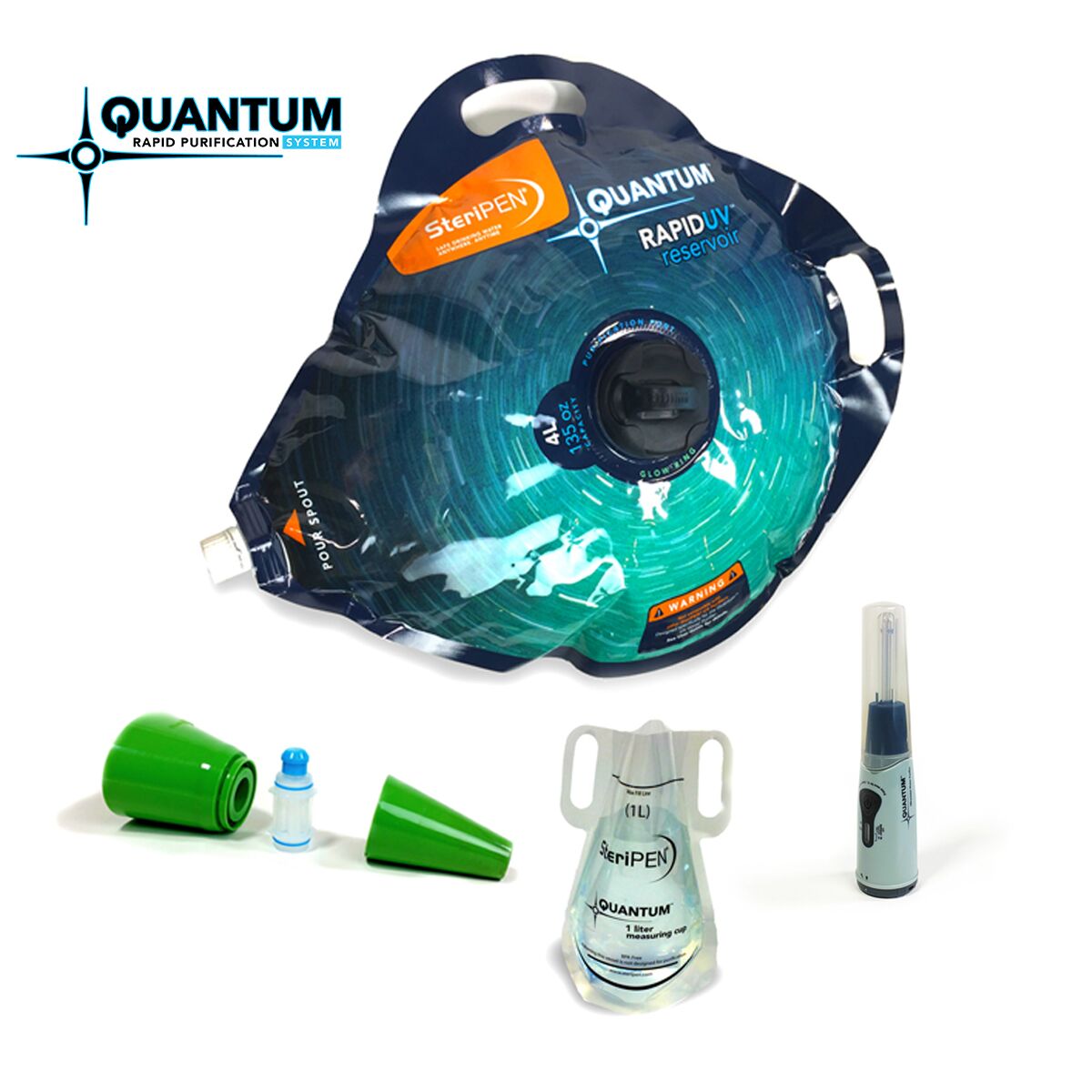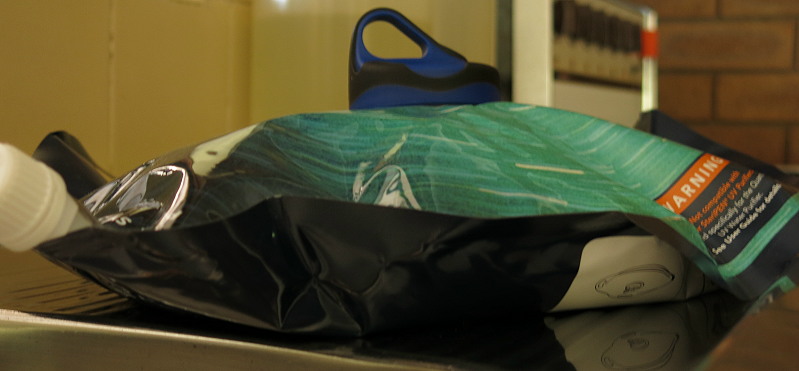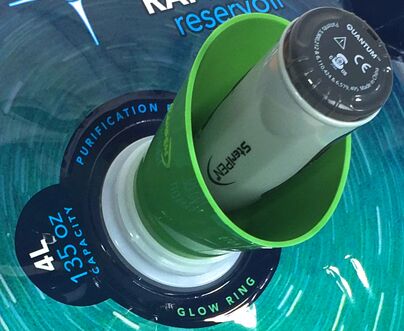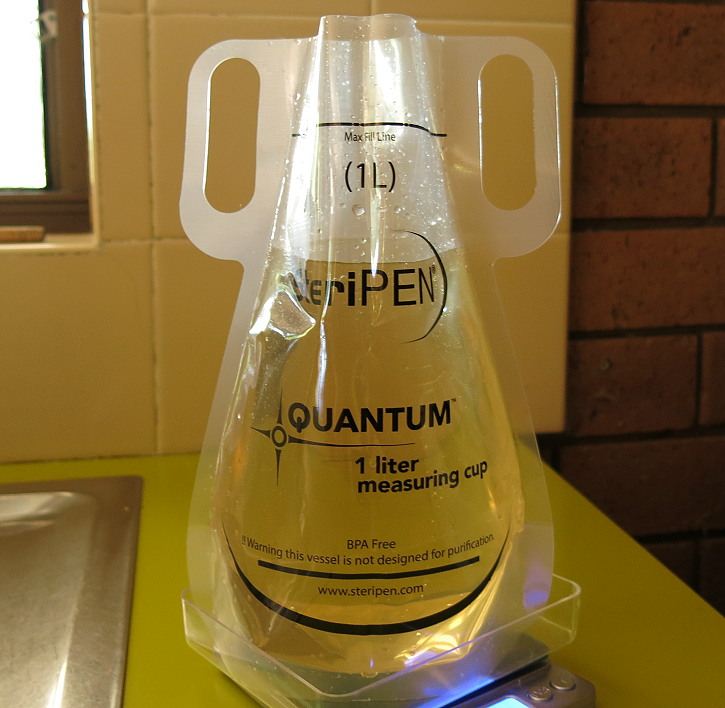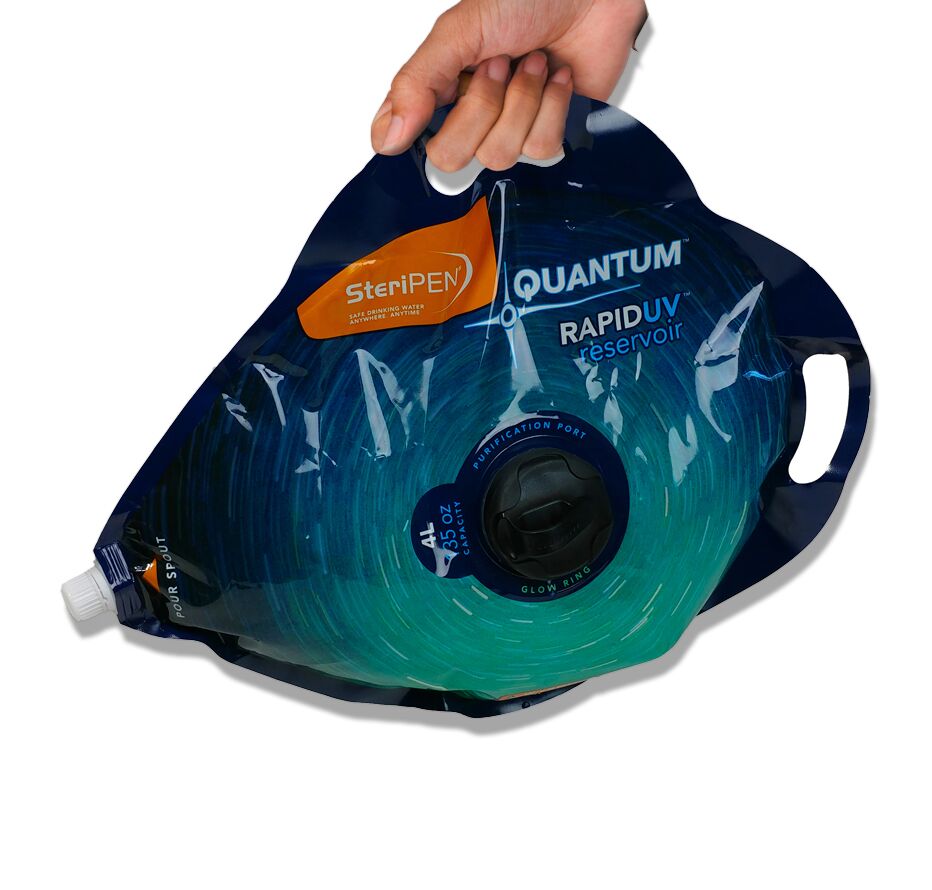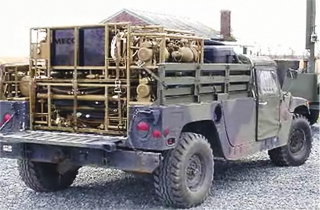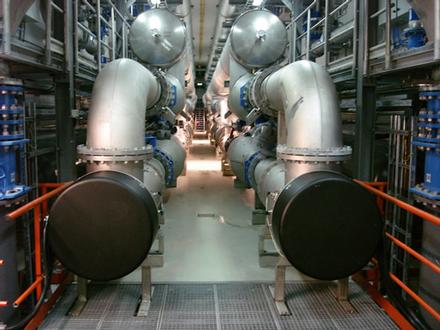Topic
Steripen Quantum UV Water Treatment System — Roger Caffin
Forum Posting
A Membership is required to post in the forums. Login or become a member to post in the member forums!
Home › Forums › Gear Forums › Gear (General) › Steripen Quantum UV Water Treatment System — Roger Caffin
- This topic has 56 replies, 14 voices, and was last updated 7 years, 3 months ago by
 Martin Farrent.
Martin Farrent.
-
AuthorPosts
-
Oct 23, 2017 at 9:37 am #3497978
Introduction
This is another interesting UV treatment system for rendering water safe for drinking. The UV radiation ‘kills’ or ‘disables’ all the viruses, bacteria and protozoa found in backcountry water. For that matter, as explained in our reviews of the original Steripen Adventurer in 2007, the Adventurer Opti in 2010 and the Classic3 in 2015, the UV method of water treatment is also used in local Council water treatment plants and by emergency services and the US Military. No tasty (or otherwise) chemicals, no filters to block up, no fuel for boiling, and it meets EPA requirements. What is not to like?However, one of the interesting things about the whole Steripen wand system for the UV treatment of water is that the UV radiation goes from the wand, through a very short path in the water, to the wall of the container. Any UV photons which have not done their job in that very short path length are absorbed by the wall of the container and wasted. What a pity. Could on improve on the ‘photon efficiency’?

The Quantum system, photo by SteripenThis waste was noted by Steripen and they have come up with an ingenious enhancement. Instead of using a metal pot or a plastic bottle to hold the water, they offer a RapidUV Reservoir. You fill it through a funnel with 4 L of water (enough for 2 people for most of a day), insert the Steripen Quantum wand, press the go button, and 150 seconds later you have 4 L of drinking water. But the wand is pretty much the same as the Classic3, which takes 90 seconds for 1 L at the same power. That is, this Quantum system is more than twice as efficient. How do they do it? Simple: the inside of the Reservoir is highly reflective, so instead of wasting all those unused photons, they get reflected back and forth through the water. It’s all done with mirrors …
The Details
The UV wand looks identical to the Classic3 except for the colours and the timing/volumes. The Classic3 does 1/2 L and 1 L (90 s); the Quantum does 1 L (90 s in any container) and 4 L (150 s), although the 4 L setting requires the RapidUV reservoir (the 1 L setting does not). The water-sensing mechanism is identical (two metal prongs), and the 1 L performance is also the same. We will focus therefore on the 4 L aspect.The unit comes with a solid but flexible plastic tag insert for the battery compartment. With it in place the batteries are all isolated. This is a wonderful idea: use it. After I removed the battery-isolating tag the first time I could not get the end cap back on. I could not see why. So I removed the batteries, replaced the batteries, and tried again – successfully. I suspect one of the batteries was not properly in its ‘slot’. Fortunately, when it works, it works easily. I did not have that problem again.

The RapidUV Reservoir, with water in itThe RapidUV reservoir is made of very heavy-gauge plastic with a big middle cap and a smaller cap on one side. It has a reflective inner lining to bounce the UV photons around. This gives the UV photons a far longer path through the water than you get with a metal pot or small bottle, which is why a single 150 second dose can treat all of 4 litres in one go. The reservoir is ‘robust’ – a bit heavier and bulkier than I had hoped for. The problem with going for something the weight of a Mylar hydrogen balloon (which would work just fine) is that it has to withstand mistreatment by the ‘average user’. A Mylar balloon would not; this reservoir should. You pay for the robustness. Incidentally, the RapidUV Reservoir can be bought separately: 2 for ~US$20.

The funnel with the Quantum in it, photo by SteripenThere is a two-part silicone rubber funnel to go with the Reservoir. Actually, the thin end will fit most any bottle, although only just for the 1.25 L rocket bottles. The middle part of the funnel drops into the big cap of the RapidUV reservoir easily: it does not clip in. I suspect this may be deliberate: make it a tight fit and you will spill water everywhere. The funnel is of course ‘squashable’. There is more: included is a small coarse mesh FitsAll filter which clips inside the funnel. ‘Coarse’ means it has no chance of stopping any bugs, but it is fine enough that it will stop most ‘floaties’. The wonderful part is that you can clean this filter just by blowing backwards through it, and it is not damaged by being squeezed or compressed.

The 1 L measuring cupHow do you measure out the 4 L of water into the Reservoir? Ah well, Steripen provide a collapsable 1 L ‘plastic bag’ with handles for this. It too is made of a stout plastic film, and the special folded bottom means it will sit upright on any flat surface. Very neat. However, one word of caution about the label on the bag. It says ‘(1 L)’ below a ‘Max Fill Line’, but that line is NOT the 1 L level. Only fill to just above the Steripen brand, as shown here.

The Reservoir, full of water, and bulging upwardsNow for the difficult part: pouring the water into the Reservoir. When empty the Reservoir sits flat – so one might expect that any water poured in will simply overflow. In anticipation of this my first test was done on the kitchen sink. I poured 1 L in. OK. So I poured a second litre in. OK. And a third, and a fourth. I did not have to hold the middle entry up in the air for this: the bag just swelled up all by itself, as shown here! That was unexpected. (Did they design it this way, or did it just happen? I don’t know.)
So I carefully removed the filter from the funnel – by first taking the funnel out, then I hit the Go button on the Quantum, and poked it into the funnel and put the funnel back in the Reservoir. The ergonomics here are much better than the original Adventurer: the Quantum is quite happy to be told to operate before it senses the water. It just waits until is is in the water before it starts. 150 seconds later the green LED flashed for success. And that was it. (There are 3 LEDs on the wand which do different things: a case of RTFM.)

Carrying a full bag around, pouring cap to left, photo by SteripenSo I removed the funnel and put the big cap back on. I could now pick the whole bag up by one of the handles. I undid the small cap (like on a rocket-base bottle) at one side and poured some treated water out. I replaced the cap and put the Reservoir down. Kind of easy.
The plastic around the big middle cap is labelled ‘Glow Ring’ (see 3rd photo). It does not glow – but the white threaded part in the middle does ‘sort of’. Certainly, you can see when the UV wand is on and when it is off.
Assessment
There is no doubt that UV treatment of water works and works well. There are no chemicals to worry about and no filters to block up – and not all filters handle viruses anyhow. The Steripen wands work well too, and the ergonomics on the current models are good. (There was a little battery hassle with the very first production batch of the Adventurer way back around 2007, but that is long past and gone.)There have been complaints about the way the wands eat up batteries. Well, they do a bit, although using good lithiums rather than cheap alkalines solves 90% of that problem. (Most of the rest is solved by the battery isolator between trips.) The Quantum improves the battery situation: Steripen are claiming 78 full 4 L cycles from 1 set of lithiums: that is a lot of water. Provided you use the plastic battery isolator between trips, most users will be able to go for several years before they need to replace the batteries.
The Reservoir and its associated bits are a bit bulky, but you need them to get the 4 L treatment and the battery life. On the other hand, you could probably dispense with all your other water bottles and bladders, which significantly reduces the other bulk. I think the Reservoir is robust enough to be able to carry a litre or so of water in your pack. The only hassle I found with the Reservoir was that I had to be just a bit careful when taking the small cap off to avoid spilling, but that is not a major problem.
Technical Details
Weight of empty Quantum wand 83 g
Weight of 4 lithium batteries ~141 g
Length of Quantum wand with cover 186 mm
Weight of funnel & filter 75 g
Weight of 1 L cup 17 g
Weight of Reservoir bag 107 g
Size of entry port 53 mm
Cost of complete system ~US$70Oct 23, 2017 at 10:46 am #3497983Thanks, Roger. It looks to be hard to fill without a lot of fussing. As a group system I am sure it works well. But, it is hard to beat a couple used soda bottles. I usually carry two 500ml water bottles (a little more than a pint.) Do they have any plans for a light, small capacity bottle? I am guessing a 1 liter silvered bottle would be good.
I really hate to carry water and would rather be a bit thirsty than carry an extra pound or two on a 4 hour hike. (There is usually water available somewhere 4-6 hours along most trails and most campsites.)
Oct 23, 2017 at 10:56 am #3497984Hi James
Do they have any plans for a light, small capacity bottle? I am guessing a 1 liter silvered bottle would be good.
Don’t know, but I don’t think the wand has any provision for a reflecting 1 L bottle, so maybe the answer is no.
Cheers
Oct 23, 2017 at 12:47 pm #3498000I keep coming back to the fact that I’ll probably always want a filter in addition – if only for tapeworm eggs. So if a filter leaves out the viruses and UV doesn’t do tapeworms, I may be needing both. The lightest possible combination would then be something like a Sawyer Mini or a Befree, and a Steripen Pure+. Which I own. But I can’t often be bothered to lug the Steripen around in addition to the filter… so I generally just take the Sawyer Mini and some Micropur.
That said, what I like about the Steripen Pure+ is USB charging… it gets its juice from the same power bank as everything else. Wastefully perhaps, that’s more important to me than efficiency (with disposable batteries).
Oct 23, 2017 at 4:27 pm #3498036Agree that for a group, this looks terrific. For a solo hiker, the plain old Steripen in a liter water bottle seems easier, perhaps. Although having four liters in camp makes sense. But since I boil dinner and breakfast, that may be overkill.
Steripen is so much easier than filtering! In the western U.S., I guess I just don’t worry about tape worm eggs and such…maybe I should?
Oct 23, 2017 at 4:48 pm #3498037No idea re the tapeworms where you are, Jeffrey.
I know that you have more real wilderness than we have in western Europe – so viruses are probably what you need to worry about least.
My problem in Germany and France is that I can forget about any type of purification lower down, much of the time. No system will deal with chemical pollution from agriculture and industry very well. On the flip side, that’s a sign of denser population, making tap water easier to acquire.
Well away from civilisation or higher up – meaning above the wheat fields, though not neccessarily above the cattle? That’s when I would use a filter and possibly also a Steripen or Micropur tablets, and I see the filter as the priority. Away from settlements, viruses that affect human beings are rarer than the larger germs, I believe. High up in the summer? South of Grenoble, you may not find much water at all.
Different set of problems. But tape worms can be evil enough to merit my especial phobia, I think. :-) Foxes are everywhere, and that’s where some of the nastiest come from.
Oct 23, 2017 at 8:04 pm #3498059So…couldn’t one make a simple sleeve out of a space blanket into which the treatment bottle could be slipped?
I realize the time of the treatment is tuned to the treatment vessel, but more UV just has to better than less :)
Oct 23, 2017 at 8:30 pm #3498065Agree with Jeffrey re matching unit to group size.
As for tape worms – they are nasty, but do they exist in the mountains? I have not heard of any reports, but maybe I am ignorant. My understanding is that the main vector is under-cooked meat.
Cheers
Oct 23, 2017 at 8:34 pm #3498066couldn’t one make a simple sleeve out of a space blanket into which the treatment bottle could be slipped?
Great idea, but I don’t think it can work. My understanding is that when a UV photon hits the wall of a plastic water bottle, it is usually absorbed, not transmitted. So you would need to flash the inside of your bottle with aluminium for this to work.
That is possible of course, but it might be a significant research project!Cheers
Oct 23, 2017 at 9:37 pm #3498075Great idea, but I don’t think it can work.
If it reflects anything at all, it couldn’t hurt.
Oct 23, 2017 at 9:42 pm #3498077If it reflects anything at all, it couldn’t hurt.
I can’t have been clear enough. I don’t think any UV photons will get out through the wall of the bottle, so there will be nothing to reflect back in.Cheers
Oct 23, 2017 at 10:13 pm #3498081I noticed a UVC LED http://www.cisuvc.com/products/klaran
10 V, 350 mA for one LED, a Lithium battery could provide that power, intended for disinfecting, 260 – 270 nm wavelength
I wonder if Steripen will make a unit using something like this. I assume this would be more efficient than the lamps they use
Oct 23, 2017 at 10:31 pm #3498084These UVC LEDs have been a long time in development. They started at the micro-Watt level. I know the guy who started Steripen, and I know they have been yearning for these for years.
While the web site does not give pricing, trust me: they will start out more expensive than a Steripen unit! But cost will come down.
Cheers
Oct 23, 2017 at 11:39 pm #3498098I expect cellar pack bladders are now both water storage for camp and the treatment container. 40 grams for 4 litres capacity.
Added – 2 x 90 second blasts with my Classic 2 for 4 litres.
Oct 24, 2017 at 12:16 am #3498104<p style=”text-align: left;”>I wonder if they’ve experimented with a backpacking version of a flow purifier? As water trickles through a hose it would be purified. Smaller volume/area, but less time. I assume that’s how they purify large water systems. I’m sure they don’t have a crane sized Steripen.</p>
Oct 24, 2017 at 2:07 am #3498119Hi Bob
As water trickles through a hose it would be purified.
Nice idea, but I am not aware of any EPA-rated systems which can do this. You would need an incredibly long tube – hundreds of metres maybe.I’m sure they don’t have a crane sized Steripen.
They do, you know. The military have water treatment plants on large trailers, although I am not sure how this one works.

Council water treatment plants do use UV, and the plants can be quite large.

This is a Council UV water treatment plant. Better than Flint maybe?
You can also find both photos in our ‘A Survey of Water Hazards and Water Treatment Methods (Overview of bugs and wogs)’ starting at
https://backpackinglight.com/water_treatment_methods_part1/Cheers
Oct 24, 2017 at 3:01 am #3498129Does the bag have to be swirled/agitated while the lamp is on and inserted into the treatment bag?
Oct 24, 2017 at 3:12 am #3498131The design of the Quantum system is such that you stick the Steripen wand into the funnel in the top hole and leave it there for the 90 seconds. Swirling the wand around is not needed.
When you think about it, there is no point in swirling anyhow. The wand sticks down into the bag of water, which surrounds the wand like a large cave. The UV will go everywhere, with reflections, so what extra can swirling add?
Hth, Cheers
Oct 24, 2017 at 6:42 am #3498145Hi Roger,
I can only speak for Europe – where fox feces can contain the eggs of a particularly dangerous tapeworm species. According to Wikipedia, infection is spreading – with 72% of foxes infected in southwest Germany, but just 5% in other regions. Part of the phenomenon is linked to the successful fight against rabies, due to which fox populations are growing.
I have seen plenty of foxes in the foothills of the Alps in Germany and Austria, but I’m not sure how high up they occur.
Oct 24, 2017 at 6:48 am #3498146Hi Martin
Oh really? Oops – bad news!
I have no idea how high foxes can go, but I do know we have them in our snow fields in winter.
Um.Cheers
Oct 24, 2017 at 10:06 am #3498151It looks like a great system. I have read that Katadyne was in the process of buying Steripen, so I don’t know if that will affect the product in a good or bad way.
Oct 25, 2017 at 1:24 am #3498257http://www.cisuvc.com/products/klaran said $49 to $69 per LED in low quantities. I think you’d only need one. So, that’s in the ballpark of a reasonable price.
Oct 25, 2017 at 1:53 am #3498260Is it me or does this just seem like a lot of parts and a complicated process? Funnels and filters and measuring bags and batteries… YMMV/HYOH/etc but I think if I’m going to zap water I’ll just carry a normal Steripen and an extra set of batteries instead of all this gear. This seems like a lot of parts and procedures to save some battery life and complete the UV treatment a little faster.
Oct 25, 2017 at 3:22 am #3498271The Steripen Opti is about $90, retail.
That means the ex-factory cost has to be around $45.
The other parts will cost maybe $25 – 30.
That leaves $15 – 20 for the lamp.
Could be difficult.Cheers
Oct 25, 2017 at 3:42 am #3498272“Is it me or does this just seem like a lot of parts and a complicated process?”
Actually to me the four liter bag o’water, filled and zapped in ninety seconds and then carried back to camp seems much easier than any filtering process I’ve seen for the same amount of water–especially given clogs and slow flow rates and such. But this is for groups! Or maybe two or three people. I mean, read the Befree filter thread that’s on-going.
I wonder if you wouldn’t be able to eyeball four liters in the bag pretty quickly. I doubt that a half liter off either way would cause a failure.
-
AuthorPosts
- You must be logged in to reply to this topic.
Forum Posting
A Membership is required to post in the forums. Login or become a member to post in the member forums!
HAPPENING RIGHT NOW (February 11-21, 2025) - Shop Hyperlite Mountain Gear's Biggest Sale of the Year:
Our Community Posts are Moderated
Backpacking Light community posts are moderated and here to foster helpful and positive discussions about lightweight backpacking. Please be mindful of our values and boundaries and review our Community Guidelines prior to posting.
Get the Newsletter
Gear Research & Discovery Tools
- Browse our curated Gear Shop
- See the latest Gear Deals and Sales
- Our Recommendations
- Search for Gear on Sale with the Gear Finder
- Used Gear Swap
- Member Gear Reviews and BPL Gear Review Articles
- Browse by Gear Type or Brand.

